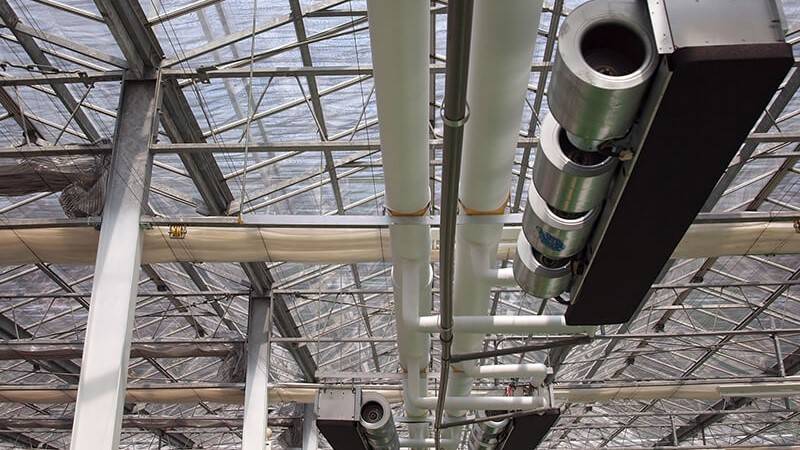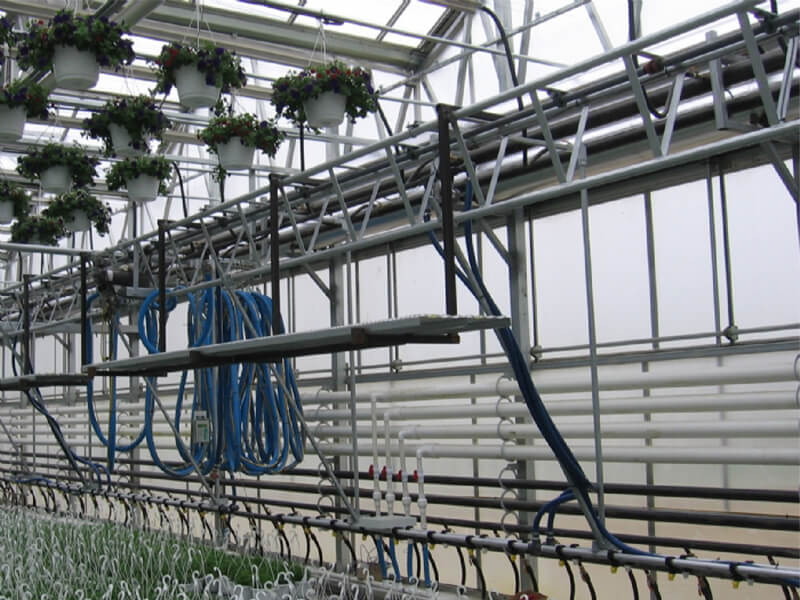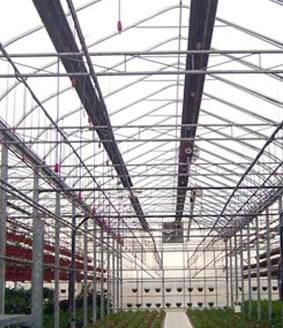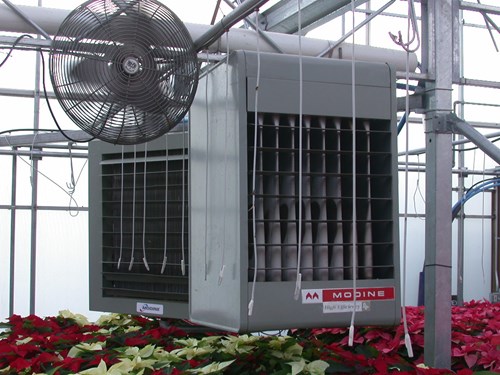Heating Systems for a Temperate Greenhouse


Global warming is a growing concern. For growers, a reduction in the use of fossil fuels* can be a way to minimize their impact on the environment. However, it can be very difficult in winter months to maintain the greenhouse at ideal temperatures for plants, even during the day.
During winter months, the strategies to conserve energy may not be enough to keep the air temperature within an optimum range, therefore, the use of fossil fuel is necessary to heat the growing environment. The criteria to be considered for its selection should be:
- The profitability of the investment
- Ensuring that the heat source is close to the plants, supporting the entire growing area while maintaining temperatures high enough to promote active plant growth
- The safety of the fuel source
Three of the heating systems that can meet the above criteria are central heating systems, infrared radiant heaters, and forced-air heater units.

Central Heating Systems
Operation
- Heat is transferred from the hot water pipe to an object; this type of heat transfer is called “radiant heat”.
- This type of heating system uses a boiler to heat water or to produce steam.
- Boilers can burn fuels like natural gas, wood, coal or fuel oil.
- Hot water systems are more efficient than steam systems.
- One by-product of the boiler is CO2. This gas can be trapped and delivered into the greenhouse to help the plants in the photosynthesis process.
- The warm water or steam must be transported in pipes throughout the greenhouse.
- The water temperature for overhead systems can be up to 200˚F (94˚C) while the water under the benches can be up to 104˚F (40˚C).
- Floor heating is another method to heat the greenhouse with hot water. With this method, pipes are placed in the ground under a layer of concrete, gravel, sand or soil. Heating pipes form loops covering the entire surface of the greenhouse. The water temperature can be up to 104˚F (40˚C).
Type of Culture
- In greenhouses dedicated to vegetable production, two pipes carrying hot water are placed in the ground, parallel to the rows and between the rows. These pipes serve to heat the greenhouse and look like train rails. Trolleys can be used on these rails to transport produce, support equipment to spray plants or support equipment for people to work on plants.
- Another option for vegetable production is to place polyethylene pipes with warm water close to the plants.
Greenhouse Type
- The pipes can be placed around the inside perimeter of the greenhouse in the case of a single-span greenhouse. For a gutter-connected greenhouse, it is recommended to install pipes close to the gutters (to melt ice) and/or under growing benches.
Notes
- This system is recommended for large operations due to high installation and hardware costs.
- The efficiency can be higher than the use of forced-air heater units because the greenhouse is heated uniformly; there is little need for ventilation.
- These systems require time to reach the desired temperature; similarly, it will take time to decrease the temperature.

Infrared Radiant Heater
Operation
- Heat is transferred from the source to an object. In the case of a greenhouse, the heat is transferred from the infrared pipe to the plant or other objects. In other words, air will not transfer the heat and air temperature will not increase or impact the plant’s temperature.
- An infrared pipe or two pipes (U shape) run parallel to the gutter along the length of the greenhouse.
- The system consists of a single burner or a series of burners along the pipe.
- The fuel source can be natural gas or propane.
- Low-intensity infrared heaters are safer to use in a greenhouse than high-intensity infrared heaters because the pipes are heated up to 1100˚F (594˚C); the pipes of a high-intensity infrared heater can be heated as high as 1800˚F (982˚C).
- The difference in heat irradiated to the floor between the source and the end of the pipe can be minimized by increasing the height of the pipe.
Notes
- Fin pipes are more efficient than bare pipes; this is due to the much larger radiation surface area of the fin pipes.
- This type of heating system delivers heat more efficiently when the heat is reflected at a 90˚ angle (facing plants) since it can cover the entire surface of the greenhouse.

Forced-Air Heater Units
Types of Forced-Air Heating
- There are two types of air heaters: vented heaters and unvented heaters. In the first type, the heat from the combustion is transferred to the air with the use of a heat exchanger; the exhaust gases from combustion must be delivered outside the greenhouse through a flue pipe. The oxygen for the combustion is obtained from the outside environment. The second type utilizes oxygen from inside the greenhouse. A drawback of this type of heater is that the gases from the combustion stay inside the greenhouse. All the heat produced by the heater is used to heat the air.
Operation
- Fuel sources used for heaters are natural gas, LP gas, kerosene and fuel oil.
- The by-products of the combustion are water vapor, carbon dioxide, carbon monoxide, ethylene, propylene and sulfur dioxide. Plants can utilize the carbon dioxide, up to a point.
- The heaters can be mounted overhead or placed on the floor.
- A greenhouse can have one unit or multiple units; this depends on the design.
- One heater and one overhead polyethylene pipe are enough to heat a greenhouse. However, smaller-diameter polyethylene tubes can be placed on the side of the benches, under the rows or between rows.
- This type of system requires fans to move the air from the source heater to the opposite side of the greenhouse. This can be achieved by installing polyethylene tubes. A tube runs parallel to the length of the greenhouse and crop rows. Ventilation holes are drilled along their lengths, perpendicular to the tubing, to distribute the heat evenly to plants.
- It is necessary to install HAF (Horizontal Air Flow) fans to move the air through the entire greenhouse. These fans help with air circulation; stagnant air can cause differences in air temperature, plants could grow unevenly, and the hot and humid microenvironment may encourage the development of diseases.
- The heater can be turned on and off depending on the temperature set points on the thermostat.
Notes
- This type of heating system is recommended for small greenhouses.
- The time required to heat the air is relatively low compared to central heating systems.
- The heat transferred to the plants is less efficient because the air has to be heated first to heat the plants (heat is transferred by convection). Therefore, the plant temperature cannot be higher than the air temperature.
In addition to the above methods, a greenhouse can be heated with the use of wasted hot water from nearby power plants. Another option is the use of geothermal heat in which hot water from the ground is pumped to the surface to provide heat to the greenhouse. Moreover, deep mines can provide hot air to a greenhouse.
Whatever method you choose to heat your greenhouse, it is imperative to consult an engineer to modify or upgrade the greenhouse, because the success of the different heating systems or the energy conservation strategies will depend on a good design.
To discover different energy conservation strategies and avoid excessive heat loss depending on the type of greenhouse and its location, read: Tips for Efficient Energy Conservation in a Greenhouse
*In this article, “fossil fuel” refers to natural gas, LP gas, coal or fuel oil.